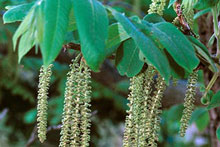Butternut trees on your property
What you need to know if you want to remove or harm a Butternut tree on your property.

About Butternut trees
Butternut trees across North America have been infected by a fungus known as Butternut Canker. This fungus usually kills the tree.
The Butternut tree is an endangered species and is protected under Ontario’s Endangered Species Act.
The law
By law, what you can do with a Butternut tree depends on its health.
Butternut trees are divided into 3 categories:
Category 1: the tree is in advanced stages of disease as a result of Butternut Canker
Category 2: the tree does not have Butternut Canker or the disease is not in advanced stages
Category 3: the tree could be useful in determining how to prevent or resist Butternut Canker
If you are planning an activity that may harm or remove a Butternut tree, you may need to obtain an Endangered Species Act authorization for your activity (such as, a permit or agreement), or, your activity may be eligible for a conditional exemption under either:
You do not need a permit if you are able to register your activity and follow the conditions of the conditional exemption.
If your activity requires an Endangered Species Act authorization or is eligible for Part V of Ontario Regulation 830/21, the first step is to have a Butternut Health Expert determine what category the tree falls into. The regulation defines the qualifications for Butternut Health Experts.
Butternut health assessments must be completed in accordance with the Butternut Assessment Guidelines: Assessment of Butternut Tree Health for the Purposes of the Endangered Species Act, 2007
Source law
This is a summary of the provincial laws. You can find a complete set of provincial rules that relate to this activity in:
- Endangered Species Act, 2007
- Ontario Regulation 242/08 (general)
- Ontario Regulation 830/21 (Exemptions – Species Subject to Species Conservation Charges)
This page is for informational purposes only. You should not rely on it to determine your legal obligations. To determine your legal obligations, consult the Endangered Species Act, 2007 and its regulations.
If you need legal advice, consult a legal professional. In the event of an error on this page or a conflict between this page and any applicable law, the law prevails.
Summary of the conditional exemptions
Some activities that impact Butternut trees may be eligible for conditional exemptions in Ontario Regulation 242/08 or Ontario Regulation 830/21. If your activity is not eligible, you may need to seek an Endangered Species Act permit or agreement by contacting the Ministry of the Environment, Conservation and Parks.
First steps for activities eligible for Part V of Ontario Regulation 830/21:
- have a Butternut Health Expert determine the health of the tree
- send the Butternut Health Expert’s report by email to SARontario@ontario.ca at least 30 days before the proposed activity
- allow ministry staff to visit the site during the 30-day period, if asked
After the 30 days, you can register to remove or harm:
- trees in the advanced stages of disease (Category 1) as identified in the report
- up to a maximum of 15 Category 2 trees and up to a maximum of five Category 3 trees as identified in the report – but you need to first register the activity.
After you have registered your activity, you must follow additional conditions set out in the regulation, such as:
- having a mitigation plan prepared by an expert and ensuring it is followed
- minimizing adverse effects on Butternut and its habitat, through measures such as limiting activities in the root harm prevention zones of trees you are retaining
- planting, tending and monitoring Butternut seedlings and maintaining a record of these actions
- if a Category 3 tree will be removed or harmed, planting grafted scions of the Category 3 tree in an archive such as a conservation area, nursery or arboretum and maintaining records of these actions
How to register
When you need a permit
You may need a permit if you:
- want to remove or harm more than 15 Category 2 Butternut trees or more than five Category 3 Butternut trees
To apply for a permit, contact the Ministry of the Environment, Conservation and Parks.
Learn how to get an Endangered Species Act permit or authorization.
Identify a species at risk
If you are unsure about a certain species — and would like help identifying or confirming what it is — you can see photos and get more information on Ontario’s species at risk web page.